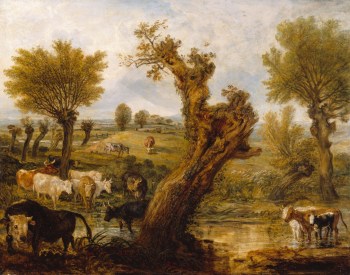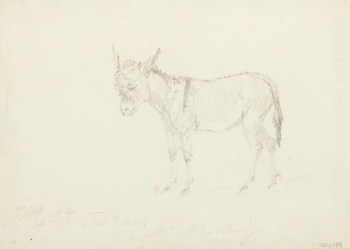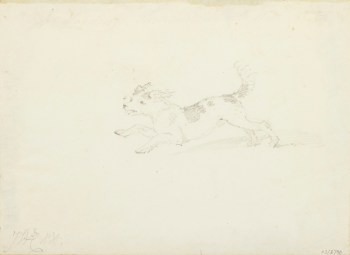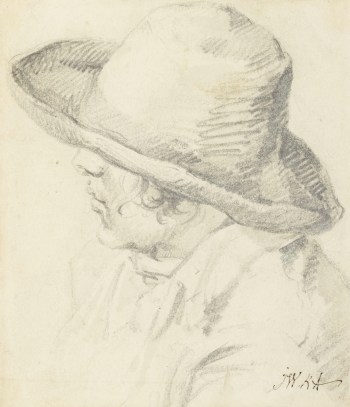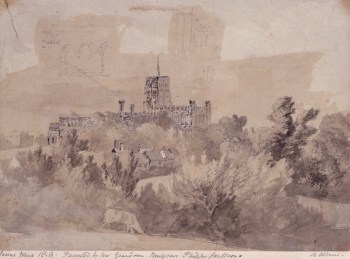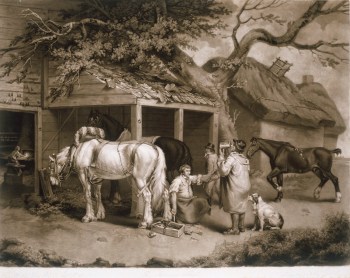James Ward RA (1769 - 1859)
RA Collection: People and Organisations
James Ward was born in 1769 in London, the son of a fruit merchant. One of five children - another of whom, William, became an associate of the Royal Academy - Ward did not attend school and instead was apprenticed to an engraver from the age of twelve. This training revealed his natural artistic talents and during his early career he established himself as a successful mezzotinter, reproducing works by other artists.
Ward started painting his own compositions around 1790 and, at first, was greatly influenced stylistically by his brother-in-law, the artist George Morland (1763-1804). After seeing Rubens’ Chateau de Steen in 1803, Ward’s painting style also incorporated Rubensian elements. He was an active observer of the natural world and studied animal and human anatomy. Ward became a respected animal-painter, often depicting animals on a colossal scale. He enjoyed a healthy business painting animals commissioned by members of the merchant classes, gentry and nobility.
Having been elected to the Royal Academy as a full member in 1811, Ward sought to diversify his subjects, and in the decades that followed, he produced renowned landscape, religious and history paintings. Ward also received significant public commissions relating to the Napoleonic Wars, notably producing The Waterloo Allegory (1815-21) to commemorate the victory of Wellington over Napoleon, for the British Institution.
A number of personal tragedies caused Ward to move from London to Hertfordshire in 1830 and, in his later years, he spent most of his time producing religious paintings although he still painted and submitted animal pictures to the RA Annual (now Summer) Exhibition. He continued to paint and exhibit until 1852, but the calibre of his work declined in tandem with his health and finances. Suffering a stroke in the mid 1850s, Ward died in November 1859.
Regarded by many as the quintessential animal painter of his generation, Ward’s paintings often had moralistic undertones that reflected his unusually progressive views. These included his hatred of cruelty to animals and defence of beards (which were extremely unfashionable at the time), and his works were sometime accompanied by lengthy explanations or poems.
RA Collections Decolonial Research Project - Extended Biography
James Ward RA (1769–1859) counted leading abolitionists among his friends and patrons and likely held anti-slavery views himself. Ward was an artist who often employed allegory in his work, and his painting The Liboya Serpent Seizing its Prey (c.1803, now lost) was an allegorical statement on the evils of the trade of enslaved Africans. The huge painting, showing a serpent wrapped around a Black African man on a white horse, was rejected by the Royal Academy for its Annual Exhibition (now known as the Summer Exhibition) in 1804. There are several studies for the work including those at the Yale Center for British Art and the British Museum.
In his work as an engraver, Ward reproduced portraits of both abolitionists and colonialists alike. In 1802, for example, he published a mezzotint after John Hoppner of Henry Thornton (1760–1815), a leading member of the anti-slavery and activist Clapham Sect. Sometime between 1806 and 1811 Ward also produced a mezzotint after Sir Thomas Lawrence of Francis Baring (1740–1810), the Director of the East India Company, and his associates.
For more information on this research project, please see https://www.royalacademy.org.uk/article/ra-collections-decolonial-research
Relevant ODNB entries
Nygren, Edward J. “Ward, James (1769–1859), painter and printmaker.” Oxford Dictionary of National Biography. 23 Sep. 2004; Accessed 1 Mar. 2022. https://www-oxforddnb-com.lonlib.idm.oclc.org/view/10.1093/ref:odnb/9780198614128.001.0001/odnb-9780198614128-e-28686
Tolley, Christopher. “Thornton, Henry (1760–1815), banker and political economist.” Oxford Dictionary of National Biography. 23 Sep. 2004; Accessed 1 Mar. 2022. https://www-oxforddnb-com.lonlib.idm.oclc.org/view/10.1093/ref:odnb/9780198614128.001.0001/odnb-9780198614128-e-27357
Profile
Born: 23 October 1769 in London, England, United Kingdom
Died: 16 November 1859
Nationality: British
Elected ARA: 2 November 1807
Elected RA: 11 February 1811
Gender: Male
Preferred media: Painting, Printmaking, Mezzotint, and Lithography
Works by James Ward in the RA Collection
13 results
-

James Ward RA
'Mr West's the President's Lap Dog', c.1805
Pencil on wove paper
-

James Ward RA
Mrs. Billington as St. Cecilia, 10 January 1803
Mezzotint
-
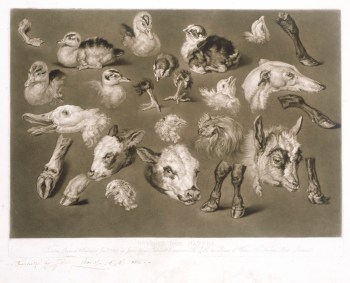
James Ward RA
Studies from Nature, 1 January 1807
Mezzotint
-

James Ward RA
The Morning Grey, 1853
Oil on panel
-

James Ward RA
Guy Mannering: A Race Horse, ca. 1822
Oil on canvas
-

James Ward RA
A donkey, 7 February 1824
Pencil on cream wove paper
-

James Ward RA
A dog running, c. 1824
Pencil on cream wove paper
-

James Ward RA
Head and shoulders of a figure wearing a broad-brimmed hat, by 1859
Pencil and wash on cream wove paper
-

James Ward RA
A lioness, 1827
Pen and ink on cream wove paper
-

James Ward RA
A preparatory drawing for 'Discord', after 1811
Pencil, pen and ink on light grey laid paper
-

James Ward RA
Bacchanalian, 1811
Oil on canvas
-

James Ward RA
A view of St Alban's, by 1859
Pencil and brown wash on cream laid paper
-

James Ward RA
A Suffolk Carthorse, ?early 19th century
Oil on canvas
Works after James Ward in the RA Collection
5 results
-

After James Ward RA
The Mouse Trap
Line-engraving (on steel?)
-

After James Ward RA
The Farrier's Shop, ca. 1796-97?
Mezzotint
-

John Scott
Chère at Ellen's Tomb, 1813-23?
Line-engraving
-

Cosmo Armstrong
Eagle, a celebrated stallion, 1809-10?
Etching and engraving
-

John Scott
A Stallion loose, 1818?
Etching and engraving
Works associated with James Ward in the RA Collection
1 results
Associated books
3 results
-
James Ward RA
An essay written in defence of the beard / [by] James Ward; with wood engravings by Roy Morgan - London: 1954
15/4378
-
James Ward RA
The battle of Waterloo : in an allegory, painted for the directors of the British Institution,founded June 4, 1805, for the express purpose of encouraging the fine arts. Now exhibiting at the Egyptian Hall, Piccadilly / by James Ward, Esq. R.A. - London: 1821
24/1015
-
Some Account Of Mary Thomas Of Tanyralt In Merionethshire, Who Has Existed Many Years Without Taking Food: And Of Ann Moore, Commonly Called The Fasting Woman Of Tutbury. Accompanied With Portraits and Illustrative Etchings. By James Ward, Esq. R.A. - London:: 1813.
04/3205



